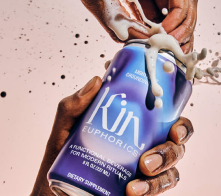What Is customer retention?

Customer retention refers to the number of people who make repeat purchases from a business. Growth hackers will tell you that by increasing customer retention rates, you can often increase your revenue faster.
The thing is, customer retention can be difficult for e-commerce businesses because there are so many alternatives available for consumers. However, a retention marketing plan can help you improve customer retention and increase your bottom line.
Without retention marketing, you're constantly prospecting for potential customers rather than focusing on building a loyal customer base. The truth is you need to do both, but many e-commerce businesses focus on the new consumer.
Here we discuss retention marketing and industry technology and offer five solutions to keep customers coming back.
What Is Retention Marketing?
Retention marketing focuses on engaging returning customers rather than targeting new ones. The goal is to increase customer loyalty by consistently giving them added value and more opportunities to purchase your products.
McKinsey Insights reports in 2022, more US consumers switched brands and retailers, looking for value. What's more, a little over a third of consumers opted to buy from private labels.
While your business needs new and returning customers, retention marketing will increase customers' lifetime value and long-term profitability.
Retention Marketing Tools
Retention marketing is about communication with your customers and using available technology to leverage data for actionable insights. Technology is a driver in retention marketing.
It leverages strategies to keep customers engaged and loyal to your brand based on relevant data. Real-time reporting tools provide deep insights into:
- Contacts
- Revenue
- ROI
- Trends
- Usage
Additionally, an integrated dashboard enables businesses to connect seamlessly to top email marketing applications, such as SalesForce and Marketo. Using technology to leverage insights and act on them is the foundation of customer retention.
5 Ways to Improve Customer Retention
If you want loyal customers, focus on building long-term relationships and delivering value throughout the customer journey.
1. Provide Friendly and Efficient Customer Support
Loyal customers spend more and will likely refer their friends and family to your brand. Reliable customer support is vital to building brand trust.
Today, customers expect to be able to reach customer support 24/7. Automation makes it possible to be there at all hours, and you can follow up if needed.
Provide customer service with easy access and accurate responses to solve customer issues. Listen and collect customer feedback. Then use it to improve customer experiences.
Nurturing customer relationships by providing ongoing service and support helps build lasting customer relationships that drive revenue.
2. Make it Personal
When your customers give social endorsements, it increases customer retention. Encourage current customers to share their thoughts on your product or service, or implement a refer-a-friend campaign encouraging customers to endorse your brand.
Communities increase customer retention. Share your vision, and talk about topics your customers are interested in that naturally relate to your products or services.
Retention marketing is all about knowing your customers. To that end, you can leverage customer data to understand their preferences and motivations. Customers will come back to make purchases if they're getting value from your brand.
Use the data to build buyer personas that represent the type of person who uses your product or service. Then create campaigns that add value for them.
3. Offer Loyalty Programs and Discounts
Loyalty programs reward your customers for buying your products and services. It can be anything from surprise swag to exclusive access that only loyal customers can purchase.
Loyalty programs and discounts show your repeat customers that you appreciate their business. Similarly, referral programs reward your customers when they send friends and family to your business.
E-commerce loyalty programs help brands build community and generate data to gain personalization insights. Consider implementing VIP benefits to increase customer lifetime value.
Social media contests encourage brand loyalty, build trust, and are a low-cost way to engage customers.
4. Dedicate More Attention to Email Campaigns
Email is an opt-in channel. Once they sign up, you can use customer emails to follow up, offer discounts, and find upsell opportunities.
To that end, it's essential to dedicate more attention to email campaigns to increase customer retention.
Email represents 50% of Latico Leathers' total revenue, and they wanted to dramatically increase their email list, drive a positive ROI, and maintain or increase their sending reputation. The company integrated Resolve with Klaviyo and experienced a 45% open rate from Resolve contacts.
You can customize email marketing campaigns and messaging for your audience. Analytics reveal which emails your customers open and don't open.
The data allows you to refine your email campaigns to suit your customers' preferences. Retention emails help build your email list, and you can segment it according to the most engaged to the least active recipients.
5. Re-engage Abandonment Revenue
First, use data analytics to measure your cart abandonment rate. If it's high, revisit your email marketing campaigns to determine why they don't resonate with your audience.
Cart abandonment could also be website related. For example, checkout may not be a user-friendly experience. Once you gather insights into why customers abandon their carts, you can set out to re-engage them.
Leverage industry-leading identity technology to increase cart abandonment revenue. For example, GetEmails enables businesses to send abandoned cart emails to users, even if they still need to opt into your newsletter.
Work With Retention Marketing Professionals
Retention.com specializes in retention marketing and e-commerce solutions, including cart abandonment and re-engaging potentially lost customers. We provide one-click integrations with leading marketing automation platforms.
Our dashboard features a user-friendly interface to easily connect to any email marketing application in under a minute. Retention's integrations automatically update and suppress contacts daily.
We can help you reclaim up to ten times more abandonment revenue by leveraging industry-leading Identity Resolution technology. When an unidentified customer abandons a cart, we identify them. Then a personalized flow automatically triggers in the messaging platform.
Scale up your abandonment flows and improve your retention marketing strategy. Get in touch with Retention.com today to find out how we can help.
7 out of 10 online shoppers abandon their carts, representing billions of dollars in lost revenue.
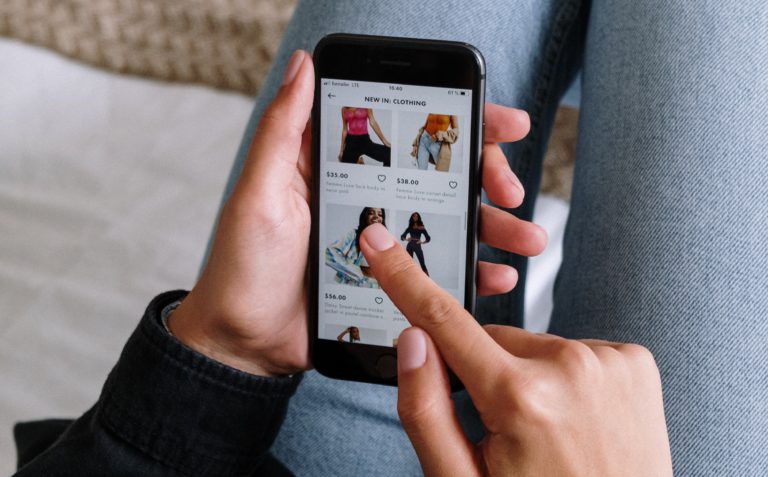
Imagine if you could instead reliably recoup even some of those lost sales.
Using retention marketing tactics, you can re-engage customers who have abandoned their carts and bring them back to your shop.
Read on to understand everything you need to start putting that lost revenue back in your pocket where it belongs.
What is Retention Marketing?

Retention marketing encourages customers to return to your website or store to make repeat purchases. It means focusing on the customer's experience and building brand loyalty to boost word-of-mouth advertising.
At its core, retention marketing means keeping the customers you already have and increasing their spending on future purchases.
Your business can utilize many effective retention marketing strategies, including reclaiming abandoned cart revenue.
The bottom line is to create engagement and loyalty in the customers you have already converted.
This loyalty also leads to reaching new customers or clients through word of mouth.
The Goal of Retention Marketing

Retention marketing aims to keep customers engaged with your company and product to increase their lifetime value to your business. The end goal of retention marketing is to increase your profits. For example, in a recent article, American Express noted that it costs 6 to 7x more to get new customers than to retain old ones.
By changing the focus to keeping customers interested and engaged with your brand, you can spend less to make more profit in a shorter time.
Why is Retention Marketing Important?
Spending less on marketing while making more sales is a dream come true. This is why retention marketing is essential to any modern business.
In addition, advertising on every platform has become much more expensive. According to Digital Information World and Business Insider, we are seeing huge increases in social media marketing costs.
For example, Facebook ads rose 89%, while advertisements on YouTube now cost 108% more than last year.
Clearly, the cost of acquiring new customers is only going up, so retention marketing is becoming even more critical.
Benefits of Retention Marketing

There are many benefits to retention marketing.
One of the most significant benefits, besides the increase in profit margins, is that it increases the lifetime value of your customers.
Happy and loyal customers will buy more, come back more often and tell others about you.
When you make efforts to engage with old customers, they reward you with increased sales. As a result, you will have to spend less on advertising.
Challenges of Retention Marketing
Understanding your customer's wants and needs deeply enough that you can keep them happy and engaged takes some work.
Likewise, setting up the required metrics to accurately measure your campaigns' results can take time.
Making sure your customers have a positive experience with your brand takes time and effort.
Customer service can be expensive and hard to get right if customers have unrealistic expectations.
It can also be challenging to show customers over time that they are still appreciated.
Retention Marketing vs. Acquisition Marketing: What's the Difference?
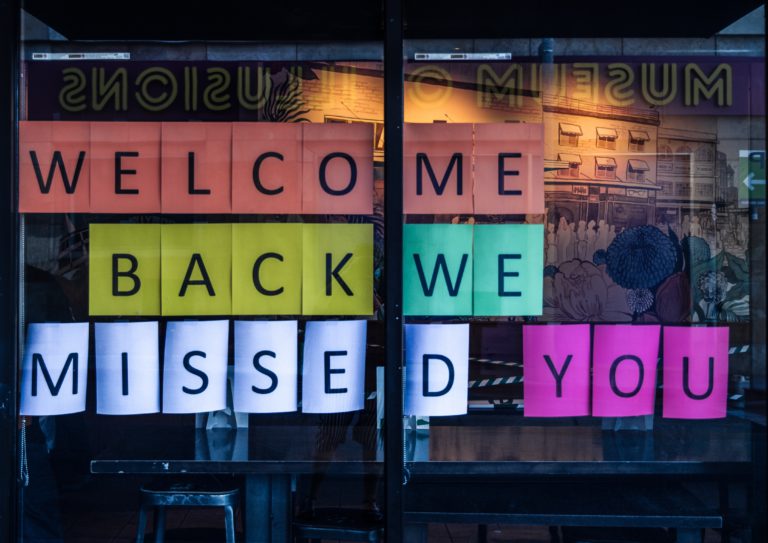
Retention marketing and acquisition marketing are two very different types of marketing. They have different goals and employ different tactics.
Acquisition marketing is more direct and easier to measure.
In contrast, retention marketing is often concerned with subjects such as loyalty, which is more of an indirect result of many combined efforts.
Main Differences Between Retention and Acquisition Marketing
The most significant difference between these tactics is the type of customer they focus on.
Retention marketing focuses on customers you already have, while acquisition marketing focuses on getting new customers.
The actions taken in Retention marketing campaigns ensure that customers continue purchasing products in the long term.
Retention marketing tactics build loyalty and connection with your customers.
In contrast, acquisition marketing strategies focus on advertising to gain new customers.
How Should You Divide Your Marketing Spend Between Retention and Acquisition
Deciding how to divide your marketing budget between retention and acquisition depends on your current customer profile.
Brandalyzer does a great job of breaking down the mathematics of this complicated formula.
However, you can't go too far wrong if you spend 75% of your marketing budget on retention.
However much you decide to spend, it is clear that focusing more on retention than on acquisition will lead to greater success for your business.
Forbes recently conducted a study, and one of the notable findings was that merchants that spent more on retention in the last 1-3 years had close to a 200% more likelihood of being successful than their counterparts who spent more on acquisition.
Types of Retention Marketing
There are many types of retention marketing, and you can choose the tactics that resonate most with your business.
For example, an online coaching portal could send personalized messages to encourage clients through SMS messaging.
Here are some other types of retention marketing campaigns:
- Reactivation: Scooping up those customers who already showed interest and giving them a great experience with your brand is one of the best retention marketing tactics available.
- Simple Returns Policy: This makes people more likely to buy if their fear of being unable to make a return easily is removed with a simple, easy-to-find policy.
- Referral: Word of mouth is the least expensive and most profitable way to get new clients.
- SMS Marketing: The most personalized way to connect with your potential clients.
- Onboarding: Usually one of the first places to focus on.
- Subscriptions: This is the best way to automate repeat purchases.
- Content: Creating content around a great cause can help build loyalty with your customers when they see your values align with their own.
- Loyalty and Rewards: This is often the best way to get your audience to buy more frequently.
- Community: Building a community of people who share values and creating a sense of belonging with your customers will keep them loyal for a lifetime.
What Are the Most Effective Retention Marketing Tactics?
Retention marketing tactics don't have to be expensive. However, the most effective strategies are thoughtful to engage repeat customers.
Email marketing to recapture abandoned cart revenue is one of the most profitable and effective strategies.
According to the Harvard Business Review, It is best to concentrate on the initial experiences a customer has with you in your retention marketing efforts.
Focusing on the first purchase experience statistically brings the most ROI and should be taken care of first in a retention marketing campaign.
Personalization as an Effective Retention Marketing Campaign
Personalization can be used to enhance any of the other highly effective tactics mentioned above. You can employ personalization as a tactic through the many stages of the customer's journey.
Personalization as a retention marketing strategy has been shown to increase the number of customers a business gains and their lifetime value to you.
This personalization tactic provides valuable content across channels like email, social media, or even (SMS) text messages!
Which Retention Marketing Tactics are Right for Your Business?
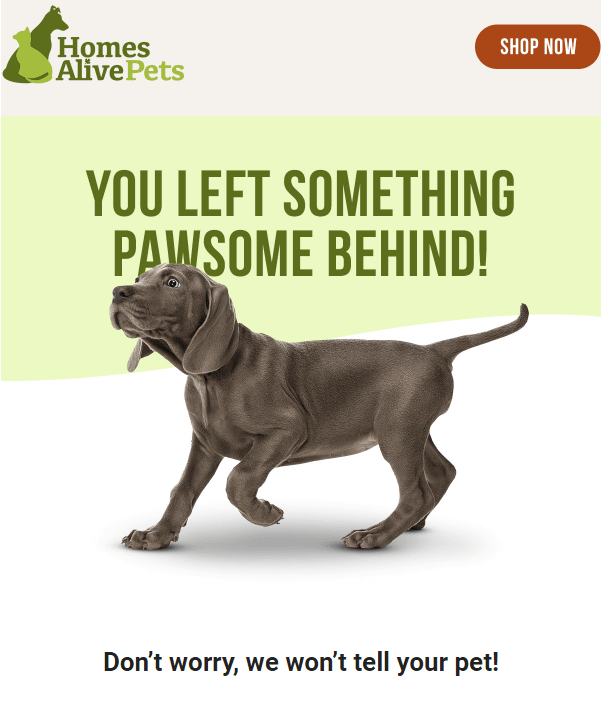
Finding the right tactics for your business can depend on your niche. Make data-driven decisions to decide on the best customer retention strategy.
First, find the right tools and formulas and measure your customer's data.
Then find out what successful metrics are for your business.
Looking at what successful metrics are for your industry is an effective way to begin. Then measure your customer data.
With the data in hand, you can see where you fall short. This will empower you to create the best retention marketing tactics for your business.
How to Create an Effective Retention Marketing Strategy
Decide what tactics will bring you the most profit and quickest returns. Target these first to create an effective retention marketing strategy.
Using the right tools is integral to creating an effective retention strategy. They will help you determine your goals and inform your strategy.
For example, if you recognize that you have a lot of dead emails on your list and want to bring these lost customers back, you can utilize Retention.Com's Reactivate campaign. This can help you increase your email opening rate from 2-3% all the way up to 40%.
What Tools Should be Implemented?
Having Customer Retention Management tools and identity resolution software can make all the data about your customer base easily accessible.
Another way to increase customer satisfaction while gathering data about them is to install a chatbot on your website.
When you have the information you need about your customers, it is much easier to tailor content for them.
Steps to Creating Your Retention Marketing Strategy
To create an effective retention marketing strategy, we recommend the following steps:
- Determine your churn rate.
- Make a User Journey Map.
- Focus on the first purchase experience and onboarding to begin.
- Use behavior analysis tools.
- Create personalized customer communications using data.
- Implement an easy way to collect feedback from your customers.
It is a great idea to concentrate first on the projects that will give you the most significant return and then go to the less profitable but still rewarding projects. For example, focus on the first purchase.
How to Measure the Success of Your Retention Marketing Efforts
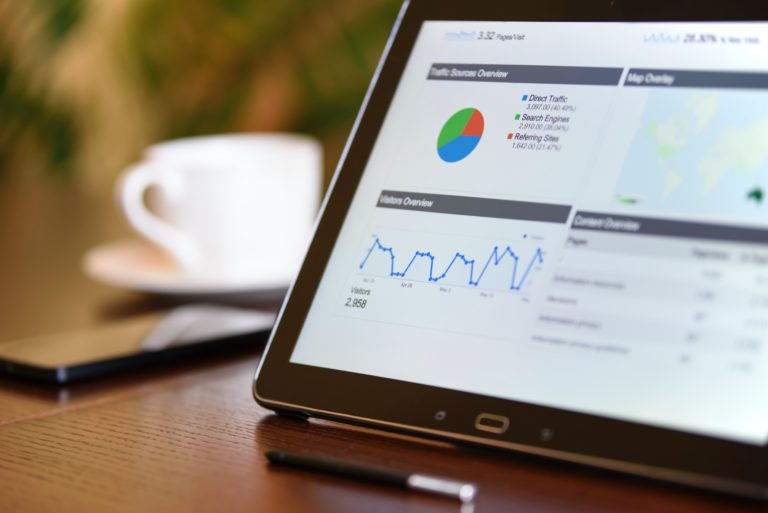
Measuring the success of your marketing efforts with cutting-edge tools that give you accurate data will bring you the most accurate results.
Use mathematical formulas that allow you to accurately pinpoint your statistics.
You can find many of these on the Appcues Blog, where they explain the different statistics you can measure along with the formulas.
For example, churn rate = (number of customers at the end of the year - new customers)/number of customers at the beginning of the year.
Here are some of the ways you can measure your success with your retention marketing efforts:
- Churn rate - monthly, quarterly, or yearly
- Average session duration
- Active users-weekly, monthly, daily
- Monthly recurring revenue and revenue churn rate
- Engagement Rate
- Reactivation rate
- Customer lifetime value
- Cumulative revenue
- Customer Satisfaction rate
- Net promoter score
- Renewal rate- for subscription services
Why are Success Measurements Important?
Peter Drucker, the first thought leader in business management, famously said, "If you can't measure it, you can't improve it."
To guide your strategy, measure which tactics work best with your customers. This way, you can direct your budget to the most effective campaigns.
The Best Success Measurements for Retention Marketing
In retention marketing, some of the most profitable success measures are product return rate, ROI, revenue and customer churn, customer lifetime value, repeat purchase ratio, and time between purchases.
It is best to find the measures that mean success for your niche. For example, in some niches, buying only one or two products in a lifetime is common.
Comparing the repeat purchase ratio for that business to the ratio desirable for most stores would create unrealistic expectations.
Finding out what metrics are considered successful for your niche is worthwhile.
Tools to Measure the Results of Your Campaign
Every website needs tools that measure your marketing data. These tools will let you know the ROI of your retention efforts.
Some of the essential tools are Google Analytics and Retention.com.
Combining these two tools will give you the information you need to gather the statistics to measure your retention marketing efforts.
For example, with Retention.Com, you can measure and keep track of your cart abandonment rate and the abandoned cart recovery rate.
On your Retention.com dashboard, you get real-time reporting. For example, you can easily see your revenue and ROI tracking and how many people have added to the cart, all in one place.
Re-engage with Your Customers and Reclaim Abandoned Cart Revenue
Now that you know how to start measuring your data and how you can utilize retention marketing to 5- 10x your current profit margins, nothing can stop you!
If you're still unsure how to re-engage with your customers and reclaim those abandoned carts, then book a demo with Retention.com. We can show you how easy it is.
We all recognize the value of cart-abandonment emails. But what about those lurkers who don’t actually drop something in the cart? They’re probably still interested, and may only need another touch or two to activate and become a customer.
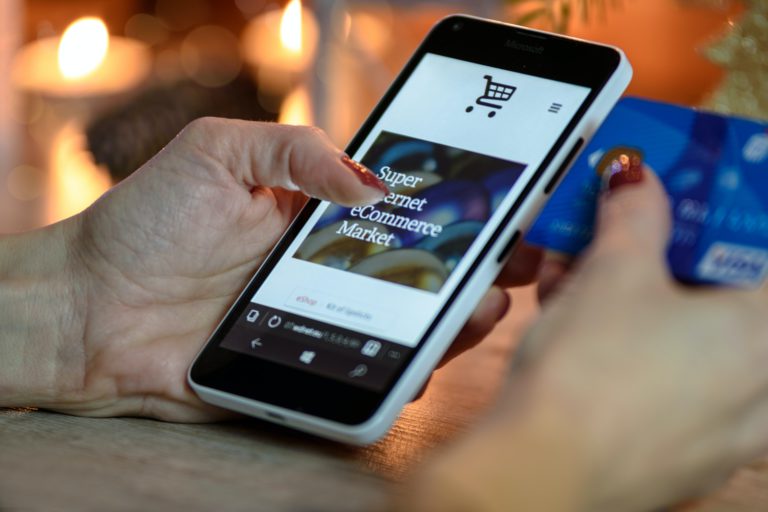
A browse abandonment email can remind them of all of the amazing products on your site that they have already viewed and how they’re missing out if they don’t click through to go back.
You don’t want to miss out on this online segment of browse abandonment shoppers because it’s quite large — and can bring you some serious ROI if you properly engage them. Just consider these stats:
- 97 percent of first-time users leave an e-commerce store without making a purchase
- 85 percent of those users never add anything to their cart
- 42 percent of revenue is generated from browse abandonment campaigns (that’s the most exciting one!)
Ready to bring these browsers back to your site so they can convert? We’ve got you covered. In this guide, we’ll explain:
- What is browse abandonment?
- The difference between browse abandonment and cart abandonment emails
- Browse abandonment email best practices
- Browse abandonment templates we love
- How to start collecting browse abandonment contacts
What is browse abandonment?

..and how is it different from cart abandonment?
- Browse abandonment is when a visitor lands on your website, views a product or category, and leaves without adding any items to their cart (and thus, not making a purchase either).
- Cart abandonment is when a visitor adds a specific item to their cart but leaves before making a purchase.
A browse abandonment prospect enjoyed looking at your products but, for whatever reason, never added the item to their cart to make a purchase. The key here is: they may be just as interested in your product but didn’t take the time to make that one extra click to drop it in the cart.
Their behavior and views will dictate the type of campaign you send them, along with any other data you have on them (ex. past purchase history).
Browse abandonment emails vs. abandoned cart emails

Both are automated flows that you should absolutely have set up in your email/SMS marketing software like Klaviyo. But it’s critical that you take a different approach for browse abandonment than you would for cart abandonment. Because the behavior and goals are different.
Someone who abandons their cart is one step closer to making a purchase, so your cart abandonment email strategy should be focused on getting them back to their cart and the specific products they left behind.
A browse abandonment email is more about reminding them of what product or category they viewed. They may have viewed one product, multiple items within a product category, or products across many categories.
A good browse abandonment strategy is about remarketing your products and brand at a slightly higher level than a cart abandonment email. And it should always be part of your owned marketing channel strategy, preferably using first-party data.
Let’s look at some of the best practices for your browse abandonment email strategy.
Browse abandonment best practices

The goal of your browse abandonment email templates is to catch the shopper’s attention and make them want to go back to your site and purchase the items they viewed.
In addition to the normal email marketing best practices, here are a few techniques specific to browse abandonment that you’ll want to follow.
Email subject lines
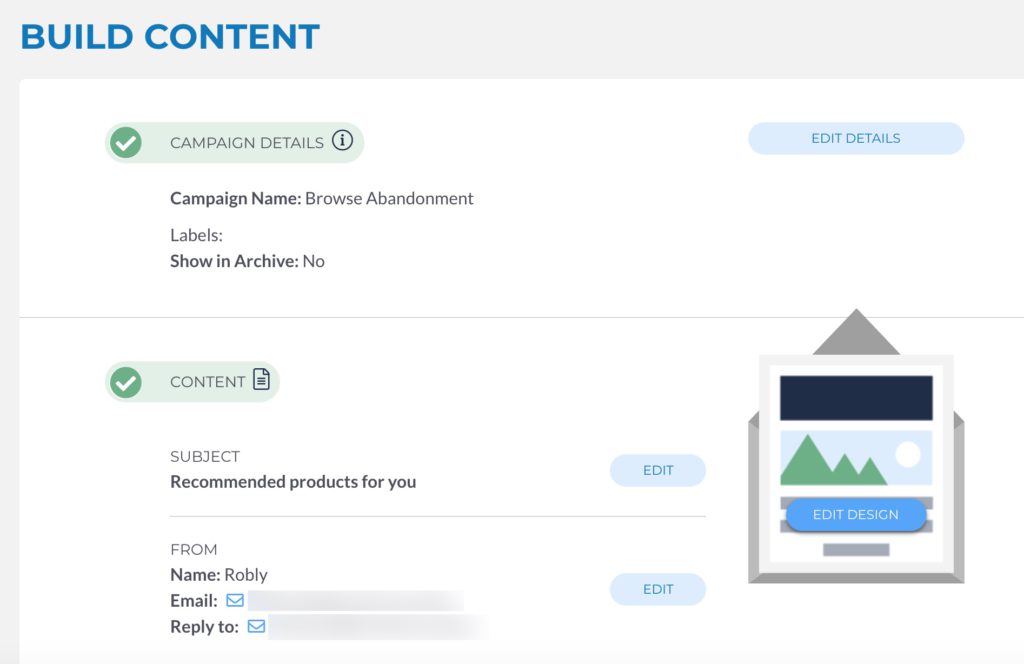
The subject line is the first thing the reader is going to see, so don’t let it disappoint. It’s either going to get them to open the email or send it to their Trash. The purpose of the subject line is to tell them why you’re emailing them and encourage them to check out whatever they were viewing.
Here are some examples of browse abandonment subject lines that work:
- Take a second look
- We saw you checking us out
- Recommended just for you
- Did you see something you liked?
- [NAME], your [PRODUCT] is waiting!
- We noticed you noticing something pretty great
- We saw you peeping…
- Caught you lurking…
These can be similar to cart abandonment email subject lines, but of course, you wouldn’t say they left something in their cart or anything like that. You would use words more like “viewed,” “saw,” or “looked.”
Stick with something that’s short, sweet, and to the point. You can add in a touch of personalization or an emoji to help the email stand out, as well.
Content

Once they open your email, you want to make it worth their while. And luckily for you, browse abandonment emails don’t have to be in-depth or flashy when it comes to the content. Actually, it’s better when they aren’t.
Here are the basic elements you’ll want in the body of the email:
- Tell them why they are getting the email (i.e. they browsed and left)
- Prominent call to action (CTA) to get back to the product(s)
- Photo, description, and price of the item(s)
All of these components make it easier for the user to recollect what they abandoned.
Here are some more in depth content tips to ensure the best possible engagement:
Create urgency
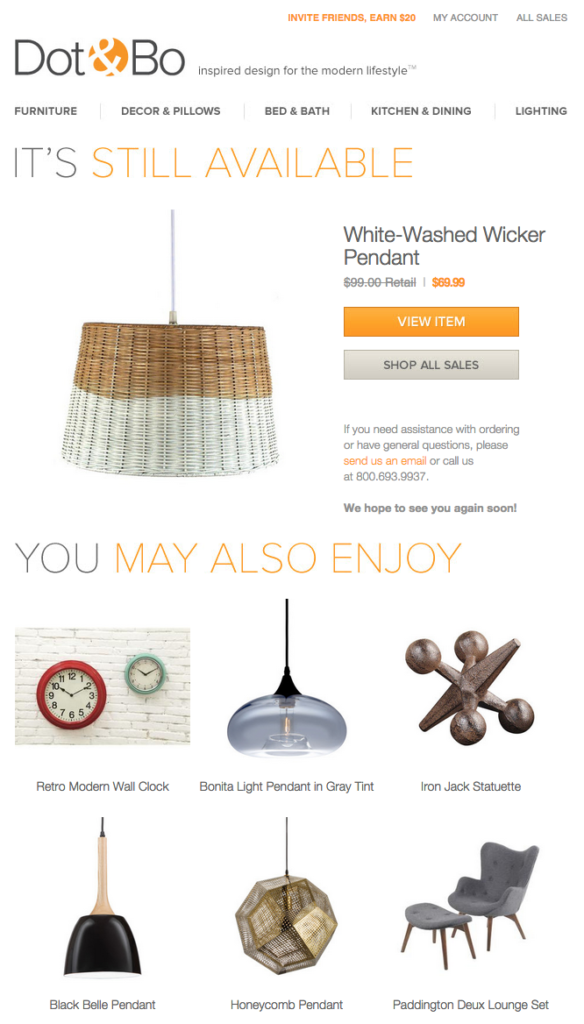
Just like you want to send the browse abandonment email shortly after they leave your site, you also want them to head back to your website ASAP. You can do that by creating a sense of urgency and fear of missing out (FOMO).
For example:
- Tell them there are only a few left — giving them a specific number of items left. Or, give them a coupon for the product category that expires in a few days. That way, they can use it on another item if the one they initially browsed wasn’t exactly what they were looking for.
Reminders
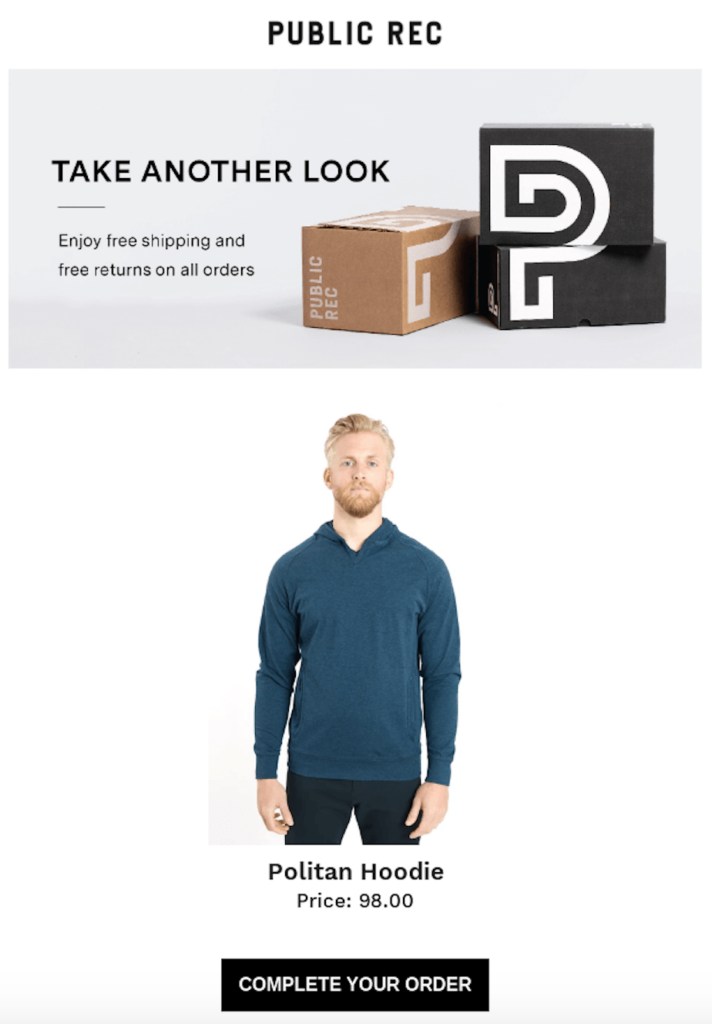
You want the shopper to know you’re emailing them because they browsed your site. If you don’t tell them why you’re emailing them, you’re simply sending a promotional email. Or, they could think it’s spam if it doesn’t specifically apply to them.
Remind them by keeping the focus on the product they viewed, and give them a clear CTA that will take them back to it.
Get Personal (not creepy)
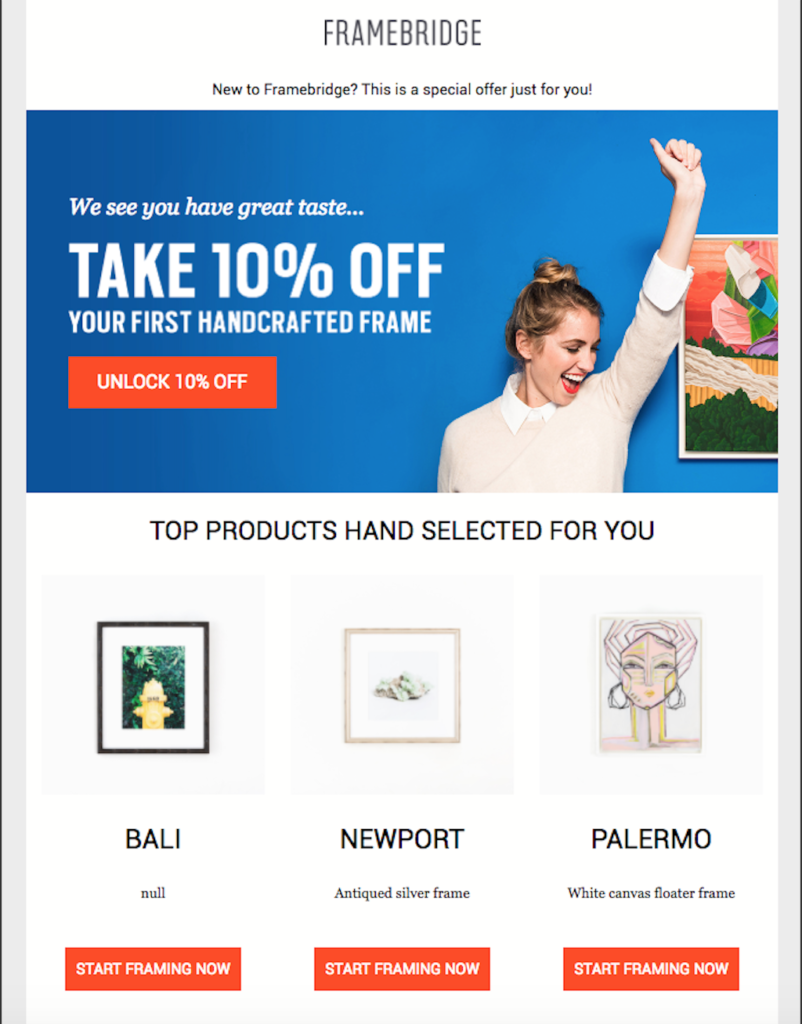
Consumers are becoming more comfortable with email retargeting, to a certain extent. And as more brands are focusing on browse abandonment, shoppers will come to expect this type of message.
To help yours stand out from the pack, add personal touches, like putting their names in the subject line or email. That will show them:
- They aren’t just a number to your company
- That you care about them as a customer
- The email is for them
- That you know what they’re interested in
While this email marketing practice isn’t new, you still want to be careful with how personal you get. People know their online behaviors are being tracked, but there’s a fine line between personalized and stalker.
For example:
You can thank them for checking out your products and include a link if they want to view it again. But, you wouldn’t want to say something like, “We see you visited our site on Monday at 1:33 p.m. and viewed these 10 pages.”
You get the point.
Recommended Products
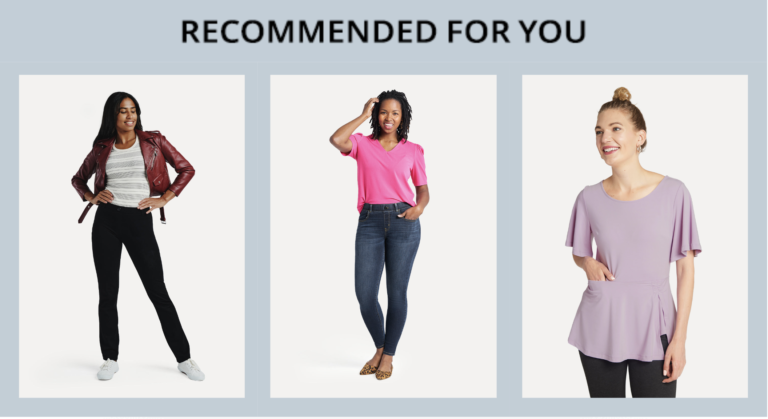
Showing the shopper recommended products is another good tactic for luring them back to your site. The customer browsed your site but didn’t want the specific item they viewed. Maybe they just didn’t find the right one?
Offer products that are similar or related to the browsed item in case they would prefer a different look, style, feature, or price point. It still provides value, even though it isn’t the exact item they originally looked at.
To pull off this method, you’ll need to make sure all of your products are correctly categorized and tagged so your automated emails are able to pull from the correct batch of items when addressing customers. Yes, this does take more work on the back end, but it can be really successful when done right.
The “recommended” approach only works if the items are actually something they would be interested in and closely related to the original item. You wouldn’t send them information on a men’s jacket if they originally viewed dog treats. (Unless it’s some really large dog that’s into wearing human clothes or something. We won’t judge.)
Email Design
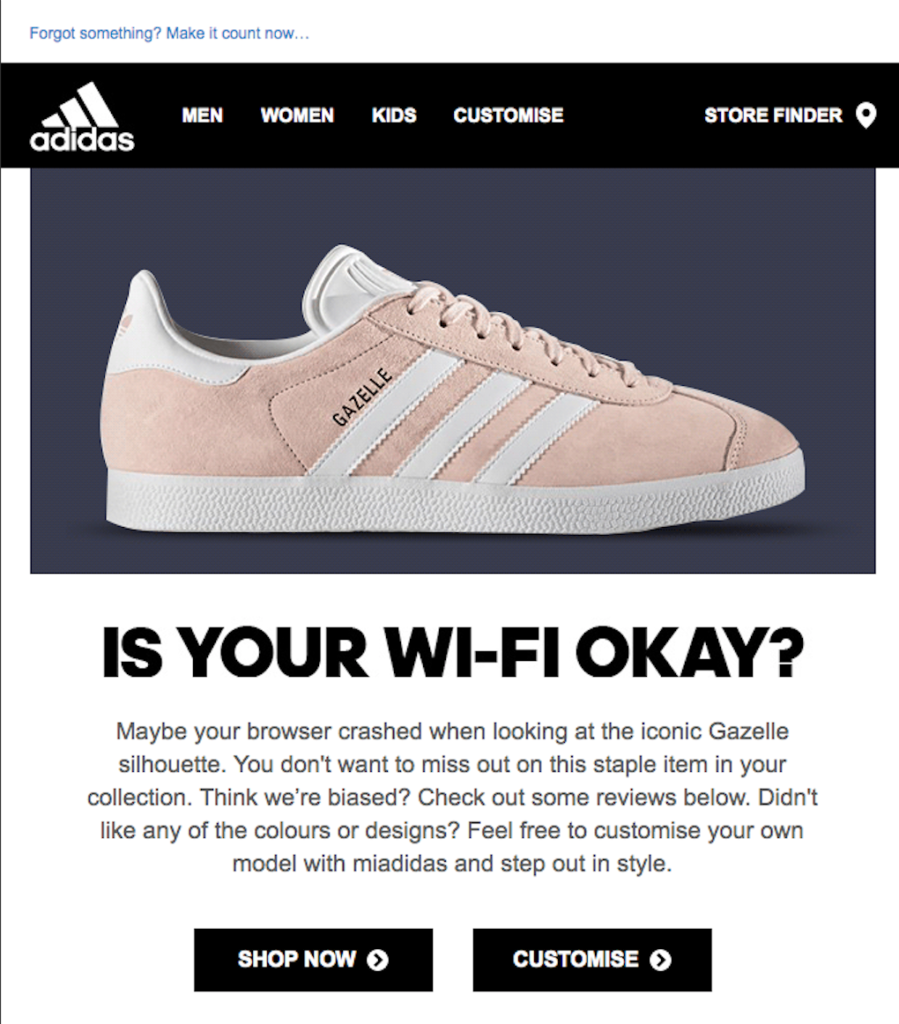
Simplicity is the name of the game when it comes to browse-abandonment templates. If your design is too cluttered, your audience will probably hit delete and move on to one of the dozens of other messages in their inbox. You have a limited amount of time (and space) to make an impression, so make it a good one.
A good technique is to make the product they viewed the main attraction, placing the image, description, and CTA to get back to it near the top of the email below your logo or related header image. If there’s more than one product they viewed, use the one they spent the most time on — or pick one as the main image and include the others at the bottom.
The idea behind showcasing the product is that if they were once interested in it, they are more likely to return to see it again, compared to a random promotional product.
Check Before Sending

Did the online shopper spend a minute on the product page, or did they view it for two seconds? The answer will determine whether or not you email them.
Sometimes visitors accidentally click a link when they intended to view another product. So, if they only spend a second or two on the page, there’s no reason to email them about it. Chances are, they won’t even recognize the product anyway.
Don’t Over-Send

If they received a browse abandonment email last week for a different product, it’s probably too soon to send them another one for the latest item they viewed.
Sending too often can make your email marketing campaigns look like sales materials (not a good thing), and they could start ignoring your messages. Or worse, they could send them to the dreaded spam folder.
Browse abandonment email templates
Now comes what you’ve been waiting for: the list of browse abandoned email templates. These emails are ones brands have sent out, but they give you an idea of what works.
Of course, you’ll want to create a template that fits your branding and voice, but these five browse abandonment email templates can give you ideas to get you started.
J.Crew
Minimal text and images do the trick in this J.Crew browse abandonment email template. The header text, “Like it? (We had a hunch.),” is to the point and engaging — the definition of short and sweet.
Instead of featuring one product, they include a CTA to the product category, “Knits & Tees,” along with a related photo. In case they aren’t that interested in the original category, J.Crew also includes links to three other categories: pants, shirts & tops, jewelry.
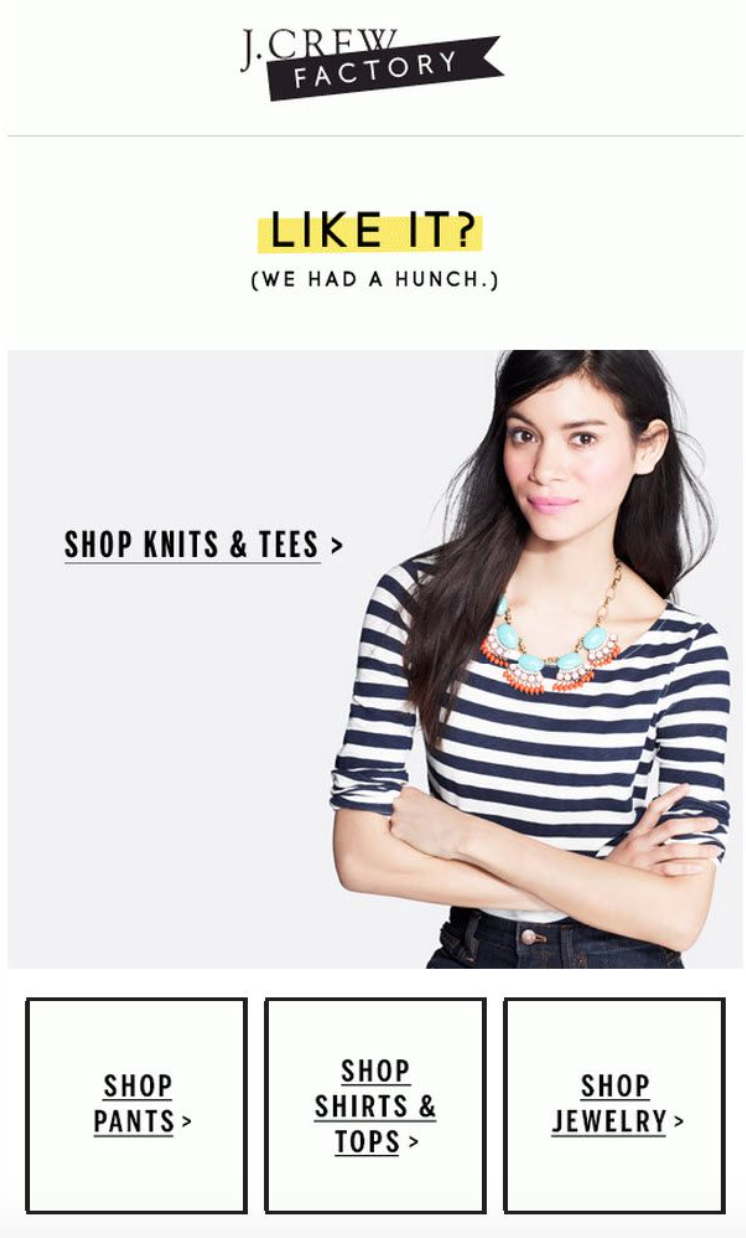
Debenhams
The U.K. brand Debenhams leads with header text that will make you want to sing: “Is it me you’re looking for?” They follow that with text that tells the reader exactly why they are receiving this email: “We noticed you’ve been looking at these items recently and don’t want you to miss out. Here they are again so you can add them to your shopping bag.”
We like how they include the product photo, description, and “View now” CTA that will take them straight back to that product. There are links to the brand’s different departments at the top of the message, as well, in case they would rather check out one of those.
This email also addresses common questions or pain points that could have kept them from completing a purchase initially:
- “We now deliver 7 days a week”
- “Free next day click & collect”
- “Plus fuss-free returns”
If shipping or returns were a concern, now this shopper knows the brand’s policies and can move forward with a purchase.
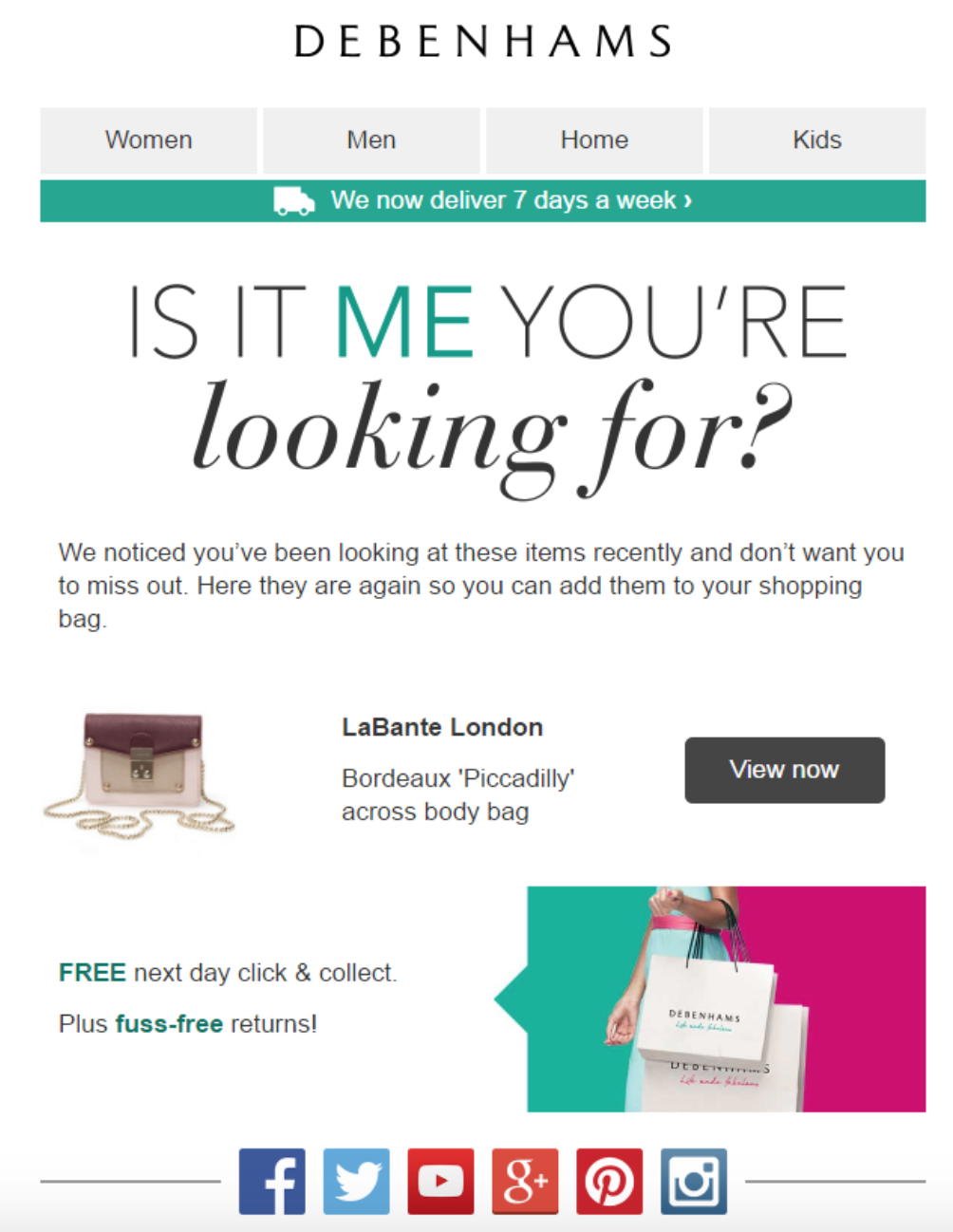
ASOS
Another U.K.-based company, ASOS does a great job with this browse abandonment email template. The header text, “Oh hello again,” gives the shopper a glimpse into why they’re receiving this email, and the body text fills in the gaps: “Sure, first impressions count, but second impressions are what really matter. Take another look at the styles you were checking out earlier.”
They then include the product photos, descriptions, and prices below so they can click whichever one they’re most interested in. And if all of those options aren’t enough, they can also click the CTA, “See what’s trending,” to see what else the brand has to offer. At the bottom of the email, they also include that they offer free delivery.

Hotel Chocolat
Not only does Hot Chocolat mention that the shopper viewed products on their page in this email — “We noticed you recently viewed our website” — but they also phrase the wording like they are doing them a favor by letting them know — “Here is a reminder of what you liked.” We love that approach because it’s not too pushy, and it provides value for the shopper.
Though the main header image isn’t the product they viewed, it does a good job of representing the brand. Then, the browsed product is just below with a photo, description, and price, which we always like to see used in browse abandonment templates.
This email example is longer than the other ones we’ve featured so far, showcasing holiday products, things they might like, and social media photos.
Although, we feel like they could have played off of their products a little more with something like, “Did you smell something sweet?” We do love a good pun.
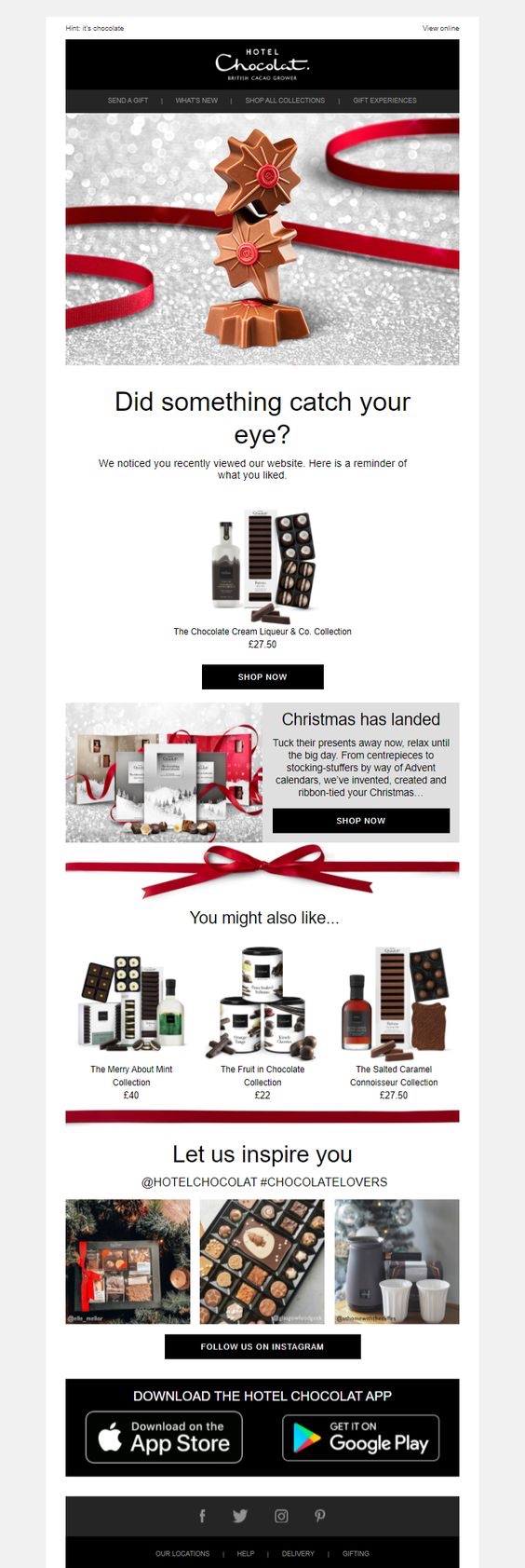
VetRXDirect
Who could say no to this adorable pup on VetRXDirect’s browse abandonment email? Definite cute points for this one. They follow that image with, “At your bark and call,” which is a perfect complement to the dog photo. Then, they get to the point, “We heard you dropped by but didn’t stay.”
The brand also puts a way for the shopper to contact their team if they have any questions, which can be a great way to win them back if the reason they didn’t purchase was because of an issue or question.
From there, they include the products they viewed, and they use a clever CTA:
That makes the shopper’s job easier and gets them even closer to converting. We also like how they tell their shipping policy and include a customer review on the company. And of course, we love the furry friends at the bottom, too.
To build customer trust with the brand, they show their verification information at the bottom of the email, as well. This email is a great example of staying true to your brand and voice, while also getting to the point that the shopper left the site before making a purchase.
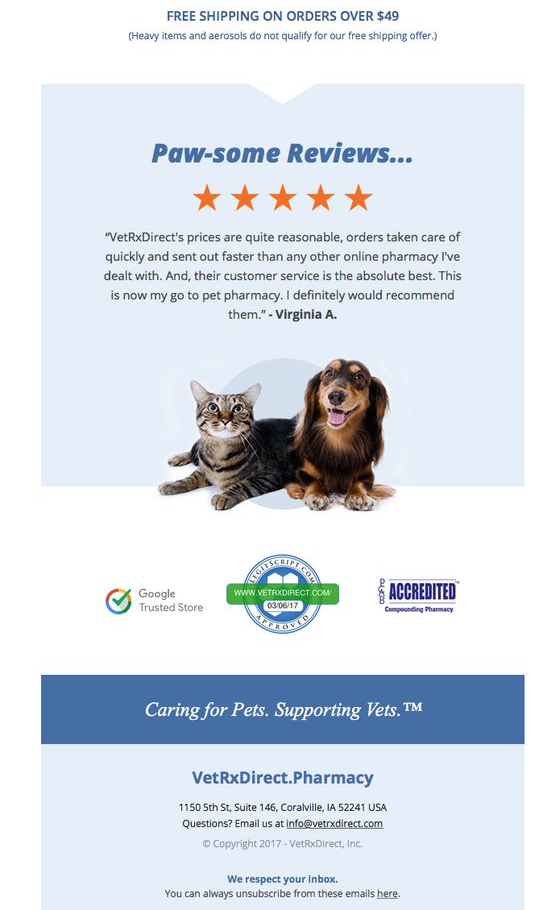
How do you identify site browsers?
You’ve designed the perfect browse abandonment template, so now you need to know who to send it to. Using cookies to identify and track your current subscribers is a great option. But, what about the anonymous traffic that visits your site but never converts? That’s where Retention.com can help.
You place our snippet script on the pages you want to collect contacts, and we can identify up to 35 percent of your anonymous traffic you would otherwise lose out on. And yes, Retention.com is compliant with the U.S.’s CAN-SPAM Act.
Want to learn more?
Building a browse abandonment email template

Depending on the ESP you use for email marketing, there may be templates already designed that are meant for browse abandonment emails (or you can tweak a cart abandonment email). You can also build an email with your ESP’s design tools.
However you create the email, make sure the message:
- Tells the shopper why you’re emailing them (because they browsed and left)
- Lets them know what products they viewed so they can go back and check them out again (and hopefully make the purchase this time).
If you make that the focus of your browse abandonment template, you’ll have a solid foundation for re-engaging the shopper.
We all recognize the value of cart-abandonment emails. But what about those shoppers who don’t actually drop something in the cart? They’re probably just as interested, and may only need another touch or two to activate and become a customer. This is where browse abandonment best practices can help.

A browse abandonment email can remind them of all of the amazing products on your site that they have already viewed and how they’re missing out if they don’t click through to go back.
In this article we will discuss some browse abandonment email best practices. If you need a more thorough primer, check out our Ultimate Guide to Browse Abandonment. And don’t forget to check out our best browse abandonment email templates and be inspired to set up your own flows!
So, you already know the why and the when of sending browse abandonment emails as part of your complete remarketing strategy, but just want to tighten up your email game? Let’s get going!
Browse Abandonment Best Practices
The goal of your browse abandonment email templates is to catch the shopper’s attention and make them want to go back to your site and purchase the items they viewed.
In addition to the normal email marketing best practices, here are a few techniques specific to browse abandonment that you’ll want to follow.
Browse Abandonment Subject Lines

The subject line is the first thing the reader is going to see, so don’t let it disappoint. It’s either going to get them to open the email or send it to their Trash. The purpose of the subject line is to tell them why you’re emailing them and encourage them to check out whatever they were viewing.
Here are some examples of browse abandonment subject lines that work:
- Take a second look
- We saw you checking us out
- Recommended just for you
- Did you see something you liked?
- [NAME], your [PRODUCT] is waiting!
- We noticed you noticing something pretty great
- We saw you peeping…
- Caught you lurking…
These can be similar to cart abandonment email subject lines, but of course, you wouldn’t say they left something in their cart or anything like that. You would use words more like “viewed,” “saw,” or “looked.”
Stick with something that’s short, sweet, and to the point. You can add in a touch of personalization or an emoji to help the email stand out, as well.
Browse Abandonment Content

Once they open your email, you want to make it worth their while. And luckily for you, browse abandonment emails don’t have to be in-depth or flashy when it comes to the content. Actually, it’s better when they aren’t.
Here are the basic elements you’ll want in the body of the email:
- Tell them why they are getting the email (i.e. they browsed and left)
- Prominent call to action (CTA) to get back to the product(s)
- Photo, description, and price of the item(s)
All of these components make it easier for the user to recollect what they abandoned.
Here are some more in depth content tips to ensure the best possible engagement:
Create urgency

Just like you want to send the browse abandonment email shortly after they leave your site, you also want them to head back to your website ASAP. You can do that by creating a sense of urgency and fear of missing out (FOMO).
For example:
- Tell them there are only a few left — giving them a specific number of items left. Or, give them a coupon for the product category that expires in a few days. That way, they can use it on another item if the one they initially browsed wasn’t exactly what they were looking for.
Reminders

You want the shopper to know you’re emailing them because they browsed your site, like this email from Public Rec. If you don’t tell them why you’re emailing them, you’re simply sending a promotional email. Or, they could think it’s spam if it doesn’t specifically apply to them.
Remind them by keeping the focus on the product they viewed, and give them a clear CTA that will take them back to it.
Get Personal (not creepy)

Consumers are becoming more comfortable with email retargeting, to a certain extent. And as more brands are focusing on browse abandonment, shoppers will come to expect this type of message.
To help yours stand out from the pack, add personal touches, like putting their names in the subject line or email. That will show them:
- They aren’t just a number to your company
- That you care about them as a customer
- The email is for them
- That you know what they’re interested in
While this email marketing practice isn’t new, you still want to be careful with how personal you get. People know their online behaviors are being tracked, but there’s a fine line between personalized and stalker.
For example:
You can thank them for checking out your products and include a link if they want to view it again. But, you wouldn’t want to say something like, “We see you visited our site on Monday at 1:33 p.m. and viewed these 10 pages.”
You get the point.
Recommended Products

Showing the shopper recommended products is another good tactic for luring them back to your site. The customer browsed your site but didn’t want the specific item they viewed. Maybe they just didn’t find the right one?
Offer products that are similar or related to the browsed item in case they would prefer a different look, style, feature, or price point. It still provides value, even though it isn’t the exact item they originally looked at.
To pull off this method, you’ll need to make sure all of your products are correctly categorized and tagged so your automated emails are able to pull from the correct batch of items when addressing customers. Yes, this does take more work on the back end, but it can be really successful when done right.
The “recommended” approach only works if the items are actually something they would be interested in and closely related to the original item. You wouldn’t send them information on a men’s jacket if they originally viewed dog treats. (Unless it’s some really large dog that’s into wearing human clothes or something. We won’t judge.)
Email Design

Simplicity is the name of the game when it comes to browse-abandonment templates. The above email from Adidas nails it. If your design is too cluttered, your audience will probably hit delete and move on to one of the dozens of other messages in their inbox. You have a limited amount of time (and space) to make an impression, so make it a good one.
A good technique is to make the product they viewed the main attraction, placing the image, description, and CTA to get back to it near the top of the email below your logo or related header image. If there’s more than one product they viewed, use the one they spent the most time on — or pick one as the main image and include the others at the bottom.
The idea behind showcasing the product is that if they were once interested in it, they are more likely to return to see it again, compared to a random promotional product.
Check Before Sending

Did the online shopper spend a minute on the product page, or did they view it for two seconds? The answer will determine whether or not you email them.
Sometimes visitors accidentally click a link when they intended to view another product. So, if they only spend a second or two on the page, there’s no reason to email them about it. Chances are, they won’t even recognize the product anyway.
Don’t Over-Send

If they received a browse abandonment email last week for a different product, it’s probably too soon to send them another one for the latest item they viewed.
Sending too often can make your email marketing campaigns look like sales materials (not a good thing), and they could start ignoring your messages. Or worse, they could send them to the dreaded spam folder.
What’s next?
So that’s it - make sure you consider the above best practices when designing your bowse abandonment email remarketing campaign, and you’ll see that engagement rate (and ROI) go through the roof!
Looking for some great examples of browse abandonment email templates? Still confused about the how, why, and when? Check out our Ultimate Gude to Browse Abandonment.
Oh, and wondering how you even get access to these browse abandoners?
How do you identify site browsers?
You’ve designed the perfect browse abandonment template, so now you need to know who to send it to. Using cookies to identify and track your current subscribers is a great option. But, what about the anonymous traffic that visits your site but never converts? That’s where Retention.com can help.
You place our snippet script on the pages you want to collect contacts, and we can identify up to 35 percent of your anonymous traffic you would otherwise lose out on. And yes, Retention.com is compliant with the U.S.’s CAN-SPAM Act.
Want to learn more?

In this article, we'll cover why email automation is important for your Shopify and Shopify+ business, especially when it comes to cart abandonment, and we'll walk you through how to do it on one of the most popular automation platforms out there - Klaviyo.
So let's get started!
What's the problem?
Have you ever been shopping online, added an item to your cart, and then left the site without completing the purchase? We've all been there. Life gets in the way, or we get distracted, and before we know it we've abandoned our cart and moved on with our day.
Sometimes we don’t even get to the point of dropping something in the cart. We browse generally, dive deep into a specific category of products, or simply spend time pondering the purchase of just one product.
As an eCommerce business owner, it's important to have email automation in place to recapture shoppers who have abandoned without purchasing. It’s core to any retention marketing plan.
Statistics show that over 70% of people who add items to their online shopping carts abandon them before completing the purchase. That's a lot of potential sales that are being lost! Not to mention the other folks who spent time browsing then disappeared. They’re probably just as interested!
With email automation, you can send a series of emails to shoppers who have abandoned their carts, abandoned their browse, abandoned a category, or abandoned a product, reminding them of the items they were interested in and giving them a special offer or incentive to complete their purchase. Email automation is a highly effective way to increase sales and revenue for your eCommerce business.
Email automation can seem daunting if you've never set it up before, but there are many software platforms out there that make it easy to get started. In this blog post, we'll give you a step-by-step guide on how to set up email automation for your eCommerce business using the popular platform Klaviyo.
Why Email Automation is Important for your Shopify or Shopify+ Businesses
Email automation is important for Shopify businesses because it helps increase sales and revenue by recapturing shoppers who have abandoned their carts. By sending a series of targeted emails reminding shoppers of the items they were interested in and providing them with a special offer or incentive, you can encourage them to complete their purchase.
According to statistics, over 70% of people who add items to their online shopping carts abandon them before completing the purchase. That's a lot of potential sales that are being left on the table! With email automation in place, you can recover some of those lost sales and boost your revenue.
Email automation can also help you create more personalized experiences for your customers and build relationships with them over time. By segmenting your email list and sending targeted emails based on shopper behavior, you can create more relevant and engaging experiences that will make customers want to do business with you again and again.
How to Set Up Email Automation using Klaviyo
Klaviyo is one of the most popular platforms for setting up email automation flows for eCommerce businesses. Klaviyo integrates with Shopify, WooCommerce, BigCommerce, Magento, and custom stores built on other platforms like ReactJS. In addition, Klaviyo offers a wide range of features and customizable options to fit the needs of any business size or type.
Follow these steps to set up your first email flow in Klaviyo:
- Log into your Klaviyo account (or create an account if you don't have one already).
- Click on "Flows" in the left sidebar menu and then click "Create Flow."
- Give your flow a name (for example: "Abandoned Cart Flow") and select "Build from Scratch."
- In the next step, select "Abandoned Cart" as your trigger event type."
- Choose when you want this flow to trigger (for example: "1 hour after an item is added to cart").
- In the next step select "Email" as your desired action type."
- Select which template you want to use for this email (you can choose from pre-built templates or create a custom template).
- Enter the subject line for your email and design your email content (you can use HTML or plain text).
- In the final step, click "Activate Flow."
Now that your flow is set up, Klaviyo will automatically send out emails according to the schedule and trigger events that you specified. You can always go back into your flow at any time and make changes if needed.
You also need a strategy for these emails
Fortunately, we have a trove of resources to help you out at every turn. Check out these articles for deep dives on the following topics:
You should find everything you need in those links to build a robust marketing program around abandonment flows.
There’s still one question in your head, though… how do I even identify who these abandoners are, if they haven’t signed up or purchased something from me in the past?
Grow Your First-Party Dataset, and Unlock A Whole New Segment of Interested Customers
Retention.com specializes in retention marketing and e-commerce solutions, including cart abandonment and re-engaging potentially lost customers. We provide one-click integrations with leading marketing automation platforms.
Our dashboard features a user-friendly interface to easily connect to any email marketing application in under a minute. Retention’s integrations automatically update and suppress contacts daily.
We can help you reclaim up to ten times more abandonment revenue by leveraging industry-leading Identity Resolution technology. When an unidentified customer abandons a cart, we identify them. Then a personalized flow automatically triggers in the messaging platform.
Scale up your abandonment flows and improve your retention marketing strategy. Get in touch with Retention.com today to find out how we can help.
Conclusion
Email automation is key for any eCommerce business that wants to boost sales and revenue. By sending targeted emails reminding shoppers of items they were interested in and providing them with an incentive to complete their purchase, businesses can increase their conversion rate and recapture lost sales.

If you're an e-commerce business owner, then you know that one of the most frustrating things is when a shopper puts items in their cart but doesn't complete the purchase. It's called cart abandonment, and it's something that all businesses deal with.
But there's no need to despair! There are ways to combat cart abandonment and turn those shoppers into paying customers. And one of the best ways is by using cart abandonment emails.
So let's get started!
Your Cart Abandonment Email Strategy
There are a few things to keep in mind when crafting your cart abandonment email strategy.
Don't Wait Too Long
First, you need to make sure that your emails are timely. You don't want to wait too long to send the email after the shopper has abandoned their cart, or else they may have forgotten about you altogether.
The general rule of thumb is to send the first email within 24 hours of abandonment. This will give you the best chance of conversion because the shopper will still remember their interaction with your store.
Of course, you will need to set up the right flows in your marketing automation software. We’ve got the goods on how to do that.
Keep it Relevant
Your next step is to make sure that your emails are relevant. This means tailoring the content of the email to match what was in the abandoned cart.
For example, if a shopper abandonment their cart because they couldn't find what they were looking for, then your email should focus on helping them find what they need.
Or if a shopper abandons their cart because they were not ready to commit to a purchase, then your email should focus on giving them a discount or special offer that will persuade them to buy from you.
The key here is relevance; if your email does not address the reason why the shopper abandons their cart, then it is unlikely to convert them into a paying customer.
There’s a lot more to this, so if you want a bit of a deeper dive, check out our guide to abandoned cart email strategy. We’ve also collected a ton of great examples of abandoned cart emails and a set of can’t-miss best practices.
Make the Sale
The last step is to make sure that your emails are persuasive. This means convincing the shopper that completing their purchase with you is the best option. To do this, you'll want to highlight why shopping with you is better than shopping with any of your competitors.
For example, you could mention free shipping or returns, exclusive discounts or offers, or superior customer service. Whatever it is that sets you apart from your competitors, make sure to include it in your email so that shoppers know exactly why they should buy from you instead of anyone else.
For more detail, read about some of the best methods for reclaiming abandoned cart revenue.
“But wait,” you’re asking yourself… “how do I even identify who these cart-abandoners are so I can email them?”
Great question…
Grow Your First-Party Dataset, and Unlock A Whole New Segment of Interested Customers
Retention.com specializes in retention marketing and e-commerce solutions, including cart abandonment and re-engaging potentially lost customers. We provide one-click integrations with leading marketing automation platforms.
Our dashboard features a user-friendly interface to easily connect to any email marketing application in under a minute. Retention’s integrations automatically update and suppress contacts daily.
We can help you reclaim up to ten times more abandonment revenue by leveraging industry-leading Identity Resolution technology. When an unidentified customer abandons a cart, we identify them. Then a personalized flow automatically triggers in the messaging platform.
Scale up your abandonment flows and improve your retention marketing strategy. Get in touch with Retention.com today to find out how we can help.
Conclusion
If you're an e-commerce business owner, then chances are you've dealt with cart abandonment at some point or another. But there's no need to despair! There are ways to combat cart abandonment and turn those shoppers into paying customers. And one of the best ways is by using cart abandonment emails. Just remember to keep your emails timely, relevant, and persuasive, and you'll be well on your way to recovering lost sales and converting shoppers into loyal customers.
Nothing is more powerful for an e-commerce brand than email automation flows. And that includes the four critical abandonment flows. They sit right at the core of any good retention marketing strategy.
From welcome emails to ongoing drip marketing campaigns to re-engagement, you want to make sure you have a robust plan to stay top of mind, without, of course, turning anyone off.
But there’s a big gap that many brands miss when rounding out their marketing strategy, and that’s abandonment flows. Today we’re going to get into the fundamental abandonment flows, and why you should have automation for each of these flows.
What are the four critical abandonment flows?

It stings when someone is so close to buying your products or services, but then for whatever reason, they never click “Purchase.” Or maybe they don’t even add an item to their cart. But they sure did think about it. Luckily, there are ways to not only capture this whole segment of window shoppers and reach out to them.
In this post, we’ll cover some of the key abandonment flows you should be thinking about and adding to your automation strategy. These abandonments include:
- Cart Abandonment
- Browse Abandonment
- Category Abandonment
- Product Abandonment
E-commerce businesses on Shopify and Shopify+ face cart, browse, category, and product abandonment every day.
Capturing shoppers who fall into these categories is important because it can lead to more sales and a better bottom line for your business.
Email marketing automation flows are an effective way to capture these shoppers and turn them into customers.
When cart, browse, category, or product abandonment occurs, an email marketing automation flow can be triggered to send a message to the shopper.
This message can include a discount code or other incentive to encourage the shopper to come back and complete their purchase.
Email marketing automation flows are easy to set up and can be a great way to boost sales and improve your bottom line.
If you haven't already, consider setting up email marketing automation flows for cart, browse, category, and product abandonment. It could be the key to increasing sales and improving your business.
Let's dig into these different types of abandonment, and why they matter.
Cart abandonment
Cart abandonment is when a shopper adds items to their cart but does not complete the purchase. This can happen for a number of reasons, such as the shopper getting distracted or finding a better deal elsewhere.
Cart abandonment is a big problem for e-commerce businesses because it can lead to lost sales and revenue.
According to Baymard Institute, the average cart abandonment rate is 69.23%. That means that for every 100 people who add items to their cart, 69 will abandon their cart without completing the purchase.
This is a significant amount of lost sales and revenue for businesses, which is why capturing these shoppers is so important.
Browse abandonment
Browse abandonment is when a shopper views products on your site but does not add anything to their cart. This can happen for a number of reasons, such as the shopper not finding what they are looking for or getting distracted.
Browse abandonment is a big problem for e-commerce businesses because it can lead to lost sales and revenue.
According to Barilliance, the average browse abandonment rate is 87%. That means that for every 100 people who view products on your site, 87 will leave without adding anything to their cart.
This is a significant amount of lost sales and revenue for businesses, which is why capturing these shoppers is so important.
Category abandonment
Category abandonment is when a shopper views products in a certain category on your site but does not add anything to their cart. This can happen for a number of reasons, such as the shopper not finding what they are looking for or getting distracted.
Category abandonment is a big problem for e-commerce businesses because it can lead to lost sales and revenue.
According to SalesCycle, the average category abandonment rate is 81%. That means that for every 100 people who view products in a certain category on your site, 81 will leave without adding anything to their cart.
This is a significant amount of lost sales and revenue for businesses, which is why capturing these shoppers is so important.
Product abandonment
Product abandonment is when a shopper views a product on your site but does not add it to their cart. This can happen for a number of reasons, such as the shopper not being interested in the product or getting distracted.
Product abandonment is a big problem for e-commerce businesses because it can lead to lost sales and revenue.
According to Invesp, the average product abandonment rate is 95%. That means that for every 100 people who view a product on your site, 95 will leave without adding it to their cart.
This is a significant amount of lost sales and revenue for businesses, which is why capturing these shoppers is so important.
What should you do about it
What marketing automation tools can Shopify and Shopify+ eCommerce brands use to create email flows for cart, browse, category and product abandonment?
There are a number of marketing automation tools that you can use to create email flows for cart, browse, category and product abandonment. Some of these tools include:
- Klaviyo
- Drip
- Hubspot
- Infusionsoft
- Marketo
Each of these tools has its own unique features and capabilities, so be sure to research each one to find the best fit for your business.
You also need a strategy
Fortunately we have a trove of resources to help you out at every turn. Check out these articles for deep dives on the following topics:
You should find everything you need in those links to build a robust marketing program around abandonment flows.
There’s still one question in your head, though… how do I even identify who these abandoners are, if they haven’t signed up or purchased something from me in the past?
Grow Your First-Party Dataset, and Unlock A Whole New Segment of Interested Customers
Retention.com specializes in retention marketing and e-commerce solutions, including cart abandonment and re-engaging potentially lost customers. We provide one-click integrations with leading marketing automation platforms.
Our dashboard features a user-friendly interface to easily connect to any email marketing application in under a minute. Retention’s integrations automatically update and suppress contacts daily.
We can help you reclaim up to ten times more abandonment revenue by leveraging industry-leading Identity Resolution technology. When an unidentified customer abandons a cart, we identify them. Then a personalized flow automatically triggers in the messaging platform.
Scale up your abandonment flows and improve your retention marketing strategy. Get in touch with Retention.com today to find out how we can help.
Conclusion
If you haven't already, consider setting up email marketing automation flows for cart, browse, category, and product abandonment. It could be the key to increasing sales and improving your business. And make sure you're capturing everyone who shows interest in your products.

Abandoned carts can be the bain of a Shopify eCommerce brand’s existence. Imagine being a brick-and-mortar store and having people walk in, fill up carts, and then simply walk out, leaving a jumble of filled shopping carts near the front door.
It happens in the outside world too, but it's epidemic online. And these abandoned carts represent billions in lost revenue. That’s why every Shopify and Shopify+ brand should have a strong abandoned cart plan as part of their overall retention marketing strategy.
This article will look at some of the top reasons that shoppers abandon their carts, and what you can do to not only minimize abandonment but also to get some of those shoppers back in to make the purchase.
Top Reasons That Shoppers Abandon Carts
Why, oh why, do they do it?
Lack of urgency
Shoppers don't feel a sense of urgency to complete their purchase when they're just browsing an online store. They can always come back later and buy the item, so there's no need to act now.Second-guessing the purchase
Second-guessing the purchase
Will this item really be worth it? Is it the best quality? Do I really need it? shoppers may have doubts about an item before finalizing their purchase.
Distractions
Online shoppers can get easily distracted by other tabs, notifications, or emails. Once they click away from your website, they may not come back.
Complicated checkout process
If the checkout process is too complicated or takes too long, shoppers get frustrated. This one happens plenty in the physical world as well.
What Can Shopify Brands Do to Prevent Abandoned Carts?
Obviously, it’s hard to control for some of the reasons above. You can’t keep a shopper from getting distracted by an email or call, can you? So you focus on what you can control. Oh and don’t worry, we’ll show get to how you win back those distracted shoppers later.
What Can You Control?
Let's focus on #4 above - a complicated checkout process. What are some of the main reasons consumers find checkout processes too complicated?
Too many steps:
Online shoppers want to be able to check out quickly and easily. If there are too many steps involved in the process, they will likely abandon their cart.
How can e-commerce brands avoid having too many steps in their checkout process?
- Use a one-click checkout option for returning customers
- Offer a guest checkout option
- Use auto-fill forms to reduce the amount of data entry required
Required account creation:
Some websites require users to create an account before they can checkout. Many shoppers simply do not want to create an account in order to complete their purchase. If this is a requirement, they will likely leave your site and find a similar product elsewhere.
What is your solution to this? Allow guest checkout. You can still capture vital information like name, address, phone and email, which every shopper expects to have to give to make a purchase. Once you have this identifying information, you can continue to market to them and convert them to account holders down the road.
Hidden fees:
Nothing is more frustrating to an online shopper than finding out there are hidden fees at the end of the checkout process. These unexpected costs can cause shoppers to abandon their purchase altogether. This can include things like shipping or VAT that were hidden from the customer until deeper into the checkout process.
You can solve this by being transparent early in the cart process as to what fees will be included, or simply add them to the total cart cost as the customer is shopping.
Confusing layout:
If the layout of the checkout page is confusing or difficult to navigate, shoppers may become frustrated and abandon. Keep it simple - customers should be able to easily go back a step and make changes without losing the inputs they have already made. Don’t make them enter info twice. The road to purchasing should be clearly marked and easy to get to.
Difficult payment options:
If the shopper is having trouble inputting payment options, they will likely prefer to buy from a competitor that has ApplePay, Paypal, or other widely-used and easily automated services. Some people simply find that getting their credit card out of their wallet is more daunting than just finding the product on another site with easier checkout options.
This one is a no-brainer, but you should be employing every mainstream payment option out there.
But even if you work against all of the above, shoppers will still abandon carts… it’s just a fact of eCommerce life. What’s a brand to do about it?
Capture abandoned cart user identity, and bring them back with email and SMS marketing.
Abandoned Cart Email Marketing
Email marketing to cart abandoners will help get them past some of the other stumbling blocks mentioned in the intro, like a lack of sense of urgency, or second-guessing the purchase. It can also help recapture shoppers who simply got distracted before they checked out.
You can send a series of email reminders, each with a different offer or incentive, to encourage them to come back and complete their purchase.
Here are some high-level tips for your abandoned cart email strategy:
- Create urgency with email subject lines: Use words and phrases like "last chance," "act now," or "expiring soon" to create a sense of urgency in your email subject lines. This will encourage shoppers to open and click through to your email.
- Use images and videos: Include images and videos in your email to help capture the shopper's attention. This can be helpful in showing off a new product or demonstrating how to use a product.
- Use countdown timers: Adding a countdown timer to your email creates a sense of urgency for shoppers to act now before it's too late. This can be an effective way to encourage abandoned cart email conversion.
- Offer discounts and coupons: Offering a discount or coupon in your email can be a great incentive for shoppers to come back and complete their purchase. Be sure to include an expiration date on the offer to create a sense of urgency.
Provide free shipping: Free shipping is another great incentive for online shoppers. If you're able to offer free shipping on an order, be sure to include that information in your email.
- Make it easy to purchase: Include a link back to the product page in your email so shoppers can easily find and purchase the item they were interested in. You may also want to consider including a guest checkout option to make it even easier for shoppers to complete their purchases without creating an account.
This is just the tip of the iceberg though…
Abandoned Carts Resource Library
Fortunately, we have a trove of resources to help you out at every turn. Check out these articles for deep dives on the following topics:
You should find everything you need in those links to build a robust marketing program around abandonment flows.
There’s still one question in your head, though… how do I even identify who these abandoners are if they haven’t signed up or purchased something from me in the past?
Grow Your First-Party Dataset, and Unlock A Whole New Segment of Interested Customers
Retention.com specializes in retention marketing and e-commerce solutions, including cart abandonment and re-engaging potentially lost customers. We provide one-click integrations with leading marketing automation platforms.
Our dashboard features a user-friendly interface to easily connect to any email marketing application in under a minute. Retention’s integrations automatically update and suppress contacts daily.
We can help you reclaim up to ten times more abandonment revenue by leveraging industry-leading Identity Resolution technology. When an unidentified customer abandons a cart, we identify them. Then a personalized flow automatically triggers in the messaging platform.
Scale up your abandonment flows and improve your retention marketing strategy. Get in touch with Retention.com today to find out how we can help.
Conclusion
Email marketing can be a powerful tool in getting shoppers to come back and complete their purchases. By using email subject lines, images, videos, and countdown timers, you can create a sense of urgency that will encourage abandoned cart email conversion. And by offering discounts, coupons, and free shipping, you can provide shoppers with incentives to come back and buy. So if you're looking to recapture lost sales, email marketing is a great place to start.

If you're a Shopify or Shopify+ brand and you don't have a solid abandoned cart recapture program, chances are you're leaving a lot of money on the table.
It's estimated that brands on Shopify miss out on around 70% of their potential sales due to shoppers abandoning their carts alone. This represents a massive segment worth targeting. But how do you capture, identify, and bring them back to seal the deal?
Let's walk through it.
How to get abandoned cart shoppers back:
Set up robust email retention and retargeting plans. What is retargeting? It’s making sure the right email goes to the right person at the right time. This is actually the hard part, even though it’s not that difficult.
It really comes down to a few things:
- The first step is to set up an automated email sequence that's triggered when someone abandons their cart. There are a number of apps that can help you with this, such as Klaviyo, Omnisend, or Seguno.
- Once you have your email sequence set up, the next step is to create compelling copy that will persuade abandoned shoppers to come back and complete their purchase. Offer a discount code or other incentive in your email to sweeten the deal.
- Finally, it's important to track your results so that you can see what's working and what's not. Most email platforms offer some sort of analytics that will allow you to see things like open rates, click-through rates, and conversion rates. Make sure to keep an eye on these metrics so that you can optimize your emails for maximum effect.
Okay, that may be a bit oversimplified. Want to know more? We've got you covered.
Abandoned Cart Marketing Resources:
Fortunately, we set up a trove of resources to help you out at every turn. Check out these articles for deep dives on the following topics:
Now, the easy part...
Capture and identify shoppers who abandon cart before purchasing
Most marketers probably think this is the hard part, but it’s actually much easier than you think. The answer? Work with Retention.com.
Retention.com specializes in retention marketing and e-commerce solutions, including cart abandonment and re-engaging potentially lost customers. We provide one-click integrations with leading marketing automation platforms.
Our dashboard features a user-friendly interface to easily connect to any email marketing application in under a minute. Retention’s integrations automatically update and suppress contacts daily.
We can help you reclaim up to ten times more abandonment revenue by leveraging industry-leading Identity Resolution technology. When an unidentified customer abandons a cart, we identify them. Then a personalized flow automatically triggers in the messaging platform.
Conclusion:
Abandoned cart emails are a powerful tool for Shopify brands looking to boost sales and close more deals.
By setting up an automated email sequence and offering a discount or other incentive, you can bring interested shoppers back to your site and convert them into paying customers.
Just make sure you're capturing everyone who stops by, not just those who sign up. And keep an eye on your metrics so that you can continue to optimize your emails for maximum effect.

Shopify brands need to focus on a few key things in order to build a strong email marketing plan that will result in more sales and conversions. Here are the five simple marketing steps for Shopify brands.
Follow these 5 simple Shopify marketing steps
1: Send relevant and targeted emails:
One of the most important things Shopify brands can do is to send relevant and targeted emails to their subscribers. This means segmenting your list and sending personalized emails that are relevant to each subscriber’s interests.
2: Use an automation platform:
An automation platform will help Shopify brands save time and energy by automating email campaigns. This way, you can set up your email campaigns in advance and emails will be sent out automatically according to your schedule.
There are a number of automation platforms Shopify brands can use, but the following five are considered to be the best for Shopify and Shopify+ direct-to-consumer brands:
- Klaviyo
- Omnisend
- Sendinblue
- HubSpot
- Drip
Each of these platforms offers different features and benefits, so brands should choose the one that best suits their needs. However, all of them offer great features that can help Shopify brands save time and energy by automating email campaigns.
3: Send timely emails:
Another important thing to keep in mind is to send your emails in a timely manner. This means sending emails when your subscribers are most likely to be engaged and checking their inboxes.
When are your subscribers most likely to be engaged and checking their inboxes?
There is no one-size-fits-all answer to this question, as it will vary depending on the Shopify brand and its subscribers. However, there are a few general things to keep in mind.
For example, sending emails during weekday mornings or evenings is usually a good time, as people are more likely to be checking their inboxes then. Additionally, brands should experiment with different times and days to see when their subscribers are most engaged and make adjustments accordingly.
4: Use engaging subject lines:
Your email’s subject line is the first thing your subscribers will see, so it’s important to make it catchy and interesting. This will entice them to open your email and read its contents.
What are some good examples of email subject lines that brands can use to be catchy and interesting?
There is no one-size-fits-all answer to this question, as the best email subject lines will vary depending on your brand and its audience. However, here are a few examples of good email subject lines to get you started:
- “New arrivals just in time for spring!”
- “Major sale! Up to 50% off everything!”
- “Introducing our newest product…”
- “You won’t believe what we have in store for you!”
- “Time’s running out! Get your hands on these deals before they disappear!”
5: Include a call-to-action:
Every email you send should have a call-to-action (CTA) that tells your subscribers what you want them to do next. Whether it’s clicking through to your website or making a purchase, make sure your CTA is clear and concise.
The best CTAs will vary depending on the brand and its audience. However, here are a few examples of good CTAs:
- “Shop now!”
- “Add to cart!”
- “Check out our latest arrivals!”
- “Sign up for our newsletter to get the latest deals!”
- “Follow us on social media for more updates!”
But the most important tip of all?
Work with retention marketing professionals
Retention.com specializes in retention marketing and e-commerce solutions, including cart abandonment and re-engaging potentially lost customers. We provide one-click integrations with leading marketing automation platforms.
Our dashboard features a user-friendly interface to easily connect to any email marketing application in under a minute. Retention’s integrations automatically update and suppress contacts daily.
We can help you reclaim up to ten times more abandonment revenue by leveraging industry-leading Identity Resolution technology. When an unidentified customer abandons a cart, we identify them. Then a personalized flow automatically triggers in the messaging platform.
Scale up your abandonment flows and improve your retention marketing strategy. Get in touch with Retention.com today to find out how we can help.
Resource Library for Shopify Marketing
Also, we have a trove of resources to help you out at every turn. Check out these articles for deep dives on the following topics:
This should get you started on the path to success.
